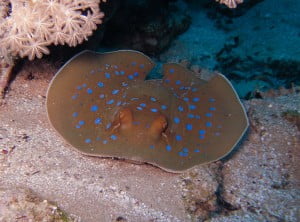The Oceania fantail (blue spotted) ray (Taeniura lessoni), named for René Lesson, the the French scientist in the 19th century who once worked on members of this genus in Melanesia.
Short description
This small, blue-spotted stingray is distinguished by the following characters:
- absence of a pair of blue longitudinal stripes along the sides of the tail;
- uniformly pale ventral fold;
- absence of the dorsal fold but upper margin of tail with a firm, blunt ridge;
- a relatively short post-orbital disc (length from rear of orbit to pectoral-fin insertion 63-65% WD), with a relatively long horizontal snout length (20-21% DW) and prenasal length 14-16% DW, and prenasal length 1.5-1.9 times internasal width
(Ref. 110363)
Update April 2017 Great Fiji Shark Count
The name for this species has been changed as of the April 2017 Great Fiji Shark Count. This has brought us in line with international taxonomic nomenclature.
- Old name used in Great Fiji Shark Count : Bluespotted ribbontail ray (brown ray)
- New name used in Great Fiji Shark Count : Oceania fantail (blue spotted) ray















